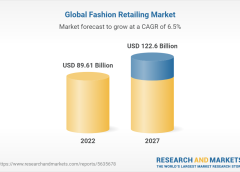
Global Fashion Retailing Market (2022 to 2027)
[ad_1]

Global Fashion Retailing Market

Dublin, Aug. 12, 2022 (GLOBE NEWSWIRE) — The “Global Fashion Retailing Market (2022-2027) by Product, Distribution Channel, Geography, Competitive Analysis and the Impact of Covid-19 with Ansoff Analysis” report has been added to ResearchAndMarkets.com’s offering.
The Global Fashion Retailing Market is estimated to be USD 89.61 Bn in 2022 and is expected to reach USD 122.6 Bn by 2027, growing at a CAGR of 6.47%.
Market Dynamics
Market dynamics are forces that impact the prices and behaviors of the Global Fashion Retailing Market stakeholders. These forces create pricing signals which result from the changes in the supply and demand curves for a given product or service. Forces of Market Dynamics may be related to macro-economic and micro-economic factors.
There are dynamic market forces other than price, demand, and supply. Human emotions can also drive decisions, influence the market, and create price signals. As the market dynamics impact the supply and demand curves, decision-makers aim to determine the best way to use various financial tools to stem various strategies for speeding the growth and reducing the risks.
Company Profiles
The report provides a detailed analysis of the competitors in the market. It covers the financial performance analysis for the publicly listed companies in the market. The report also offers detailed information on the companies’ recent development and competitive scenario. Some of the companies covered in this report are Adidas AG, Boohoo Group PLC, Gold Toe Brands Inc., Hennes & Mauritz AB, Jockey International, Inc., Ralph Lauren Corp., Uniqlo Co. Ltd., etc.
Countries Studied
-
America (Argentina, Brazil, Canada, Chile, Colombia, Mexico, Peru, United States, Rest of Americas)
-
Europe (Austria, Belgium, Denmark, Finland, France, Germany, Italy, Netherlands, Norway, Poland, Russia, Spain, Sweden, Switzerland, United Kingdom, Rest of Europe)
-
Middle-East and Africa (Egypt, Israel, Qatar, Saudi Arabia, South Africa, United Arab Emirates, Rest of MEA)
-
Asia-Pacific (Australia, Bangladesh, China, India, Indonesia, Japan, Malaysia, Philippines, Singapore, South Korea, Sri Lanka, Thailand, Taiwan, Rest of Asia-Pacific)
Competitive Quadrant
The report includes Competitive Quadrant, a proprietary tool to analyze and evaluate the position of companies based on their Industry Position score and Market Performance score. The tool uses various factors for categorizing the players into four categories. Some of these factors considered for analysis are financial performance over the last 3 years, growth strategies, innovation score, new product launches, investments, growth in market share, etc.
Ansoff Analysis
The report presents a detailed Ansoff matrix analysis for the Global Fashion Retailing Market. Ansoff Matrix, also known as Product/Market Expansion Grid, is a strategic tool used to design strategies for the growth of the company. The matrix can be used to evaluate approaches in four strategies viz. Market Development, Market Penetration, Product Development and Diversification. The matrix is also used for risk analysis to understand the risk involved with each approach. The analyst analyses the Global Fashion Retailing Market using the Ansoff Matrix to provide the best approaches a company can take to improve its market position. Based on the SWOT analysis conducted on the industry and industry players, the analyst has devised suitable strategies for market growth.
Why buy this report?
-
The report offers a comprehensive evaluation of the Global Fashion Retailing Market. The report includes in-depth qualitative analysis, verifiable data from authentic sources, and projections about market size. The projections are calculated using proven research methodologies.
-
The report has been compiled through extensive primary and secondary research. The primary research is done through interviews, surveys, and observation of renowned personnel in the industry.
-
The report includes an in-depth market analysis using Porter’s 5 forces model and the Ansoff Matrix. In addition, the impact of Covid-19 on the market is also featured in the report.
-
The report also includes the regulatory scenario in the industry, which will help you make a well-informed decision. The report discusses major regulatory bodies and major rules and regulations imposed on this sector across various geographies.
-
The report also contains the competitive analysis using Positioning Quadrants, the analyst’s Proprietary competitive positioning tool.
Key Topics Covered:
1 Report Description
2 Research Methodology
3 Executive Summary
3.1 Introduction
3.2 Market Size, Segmentations, and Outlook
4 Market Dynamics
4.1 Drivers
4.1.1 Rising Retail E-Commerce Sector
4.1.2 Increased Demand for Inclusivity and Personalization
4.2 Restraints
4.2.1 High Initial Cost
4.3 Opportunities
4.3.1 Upswing in Fast-Fashion Retail
4.3.2 VR and AI in Fashion Retailing
4.4 Challenges
4.4.1 Shrinking Profit Margins
5 Market Analysis
5.1 Regulatory Scenario
5.2 Porter’s Five Forces Analysis
5.3 Impact of COVID-19
5.4 Ansoff Matrix Analysis
6 Global Fashion Retailing Market, By Product
6.1 Introduction
6.2 Bag & Accessories
6.3 Clothing & Apparel
6.4 Footwear
6.5 Jewelry & Luxury Watch
6.6 Others
7 Global Fashion Retailing Market, By Distribution Channel
7.1 Introduction
7.2 Offline Mode
7.3 Online Mode
8 Americas’ Fashion Retailing Market
8.1 Introduction
8.2 Argentina
8.3 Brazil
8.4 Canada
8.5 Chile
8.6 Colombia
8.7 Mexico
8.8 Peru
8.9 United States
8.10 Rest of Americas
9 Europe’s Fashion Retailing Market
9.1 Introduction
9.2 Austria
9.3 Belgium
9.4 Denmark
9.5 Finland
9.6 France
9.7 Germany
9.8 Italy
9.9 Netherlands
9.10 Norway
9.11 Poland
9.12 Russia
9.13 Spain
9.14 Sweden
9.15 Switzerland
9.16 United Kingdom
9.17 Rest of Europe
10 Middle East and Africa’s Fashion Retailing Market
10.1 Introduction
10.2 Egypt
10.3 Israel
10.4 Qatar
10.5 Saudi Arabia
10.6 South Africa
10.7 United Arab Emirates
10.8 Rest of MEA
11 APAC’s Fashion Retailing Market
11.1 Introduction
11.2 Australia
11.3 Bangladesh
11.4 China
11.5 India
11.6 Indonesia
11.7 Japan
11.8 Malaysia
11.9 Philippines
11.10 Singapore
11.11 South Korea
11.12 Sri Lanka
11.13 Thailand
11.14 Taiwan
11.15 Rest of Asia-Pacific
12 Competitive Landscape
12.1 Competitive Quadrant
12.2 Market Share Analysis
12.3 Strategic Initiatives
12.3.1 M&A and Investments
12.3.2 Partnerships and Collaborations
12.3.3 Product Developments and Improvements
13 Company Profiles
13.1 Adidas AG
13.2 Boohoo Group PLC
13.3 Fast Retailing Co. Ltd.
13.4 Gap Inc.
13.5 Gildan Activewear Inc.
13.6 Gold Toe Brands Inc.
13.7 Golden Lady Company S.p.A.
13.8 Hanesbrands Inc.
13.9 Hennes & Mauritz AB
13.10 Hermes International SA
13.11 Inditex, SA
13.12 Jockey International, Inc.
13.13 Kering SA
13.14 L Brands, Inc.
13.15 Levi Strauss & Co.
13.16 NIKE Inc.
13.17 PVH Corp.
13.18 Ralph Lauren Corp.
13.19 Ross Stores, Inc.
13.20 Swatch Group AG
13.21 Uniqlo Co. Ltd.
13.22 VF Corp.
14 Appendix
For more information about this report visit https://www.researchandmarkets.com/r/66oeba
Attachment
CONTACT: CONTACT: ResearchAndMarkets.com Laura Wood, Senior Press Manager press@researchandmarkets.com For E.S.T Office Hours Call 1-917-300-0470 For U.S./CAN Toll Free Call 1-800-526-8630 For GMT Office Hours Call +353-1-416-8900

[ad_2]
Source link

